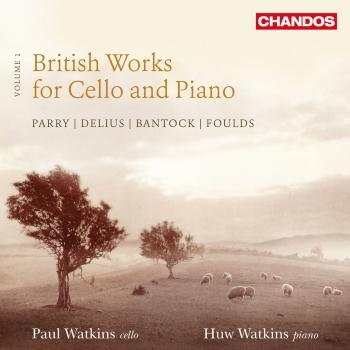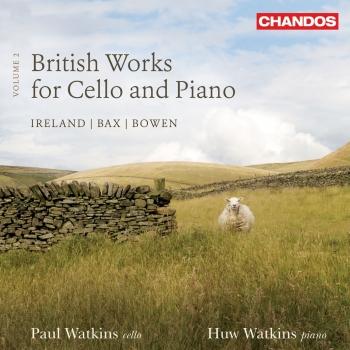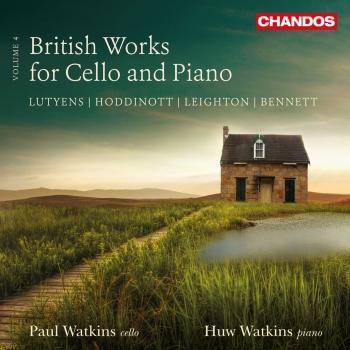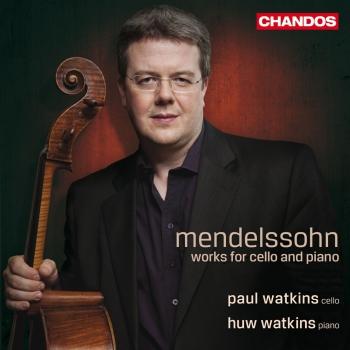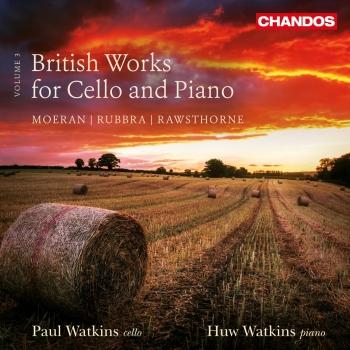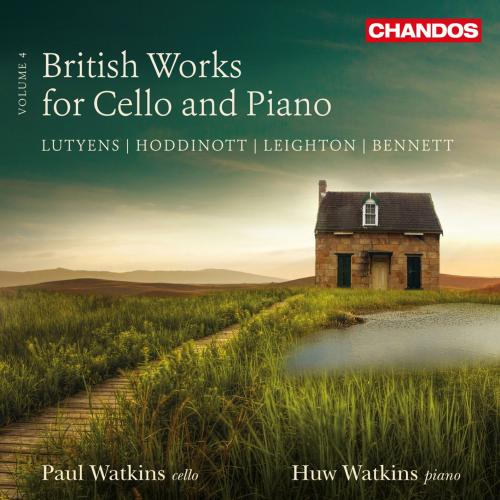
British Works for Cello and Piano, Vol. 4 Paul Watkins & Huw Watkins
Album info
Album-Release:
2015
HRA-Release:
06.12.2022
Label: Chandos
Genre: Classical
Subgenre: Chamber Music
Artist: Paul Watkins & Huw Watkins
Composer: Kenneth Leighton (1929-1988), Elisabeth Lutyens (1906-1983), Alun Hoddinott (1929), Richard Rodney Bennett (1936-2012)
Album including Album cover Booklet (PDF)
- Kenneth Leighton (1929 - 1988): Partita for Cello & Piano, Op. 35:
- 1 Leighton: Partita for Cello & Piano, Op. 35: I. Elegy 05:09
- 2 Leighton: Partita for Cello & Piano, Op. 35: II. Scherzo 04:12
- 3 Leighton: Partita for Cello & Piano, Op. 35: III. Theme 02:07
- 4 Leighton: Partita for Cello & Piano, Op. 35: III. Variation I 00:44
- 5 Leighton: Partita for Cello & Piano, Op. 35: III. Variation II 01:20
- 6 Leighton: Partita for Cello & Piano, Op. 35: III. Variation III 01:12
- 7 Leighton: Partita for Cello & Piano, Op. 35: III. Variation IV 01:06
- 8 Leighton: Partita for Cello & Piano, Op. 35: III. Variation V 01:28
- 9 Leighton: Partita for Cello & Piano, Op. 35: IV. Variation VI 03:00
- Elisabeth Lutyens (1906 - 1983): Constants, Op. 110:
- 10 Lutyens: Constants, Op. 110: I. Introduction 05:02
- 11 Lutyens: Constants, Op. 110: II. Lament 04:21
- 12 Lutyens: Constants, Op. 110: III. Canticle 03:19
- Alun Hoddinott (1929 - 2008): Cello Sonata No. 2, Op. 96 No. 1:
- 13 Hoddinott: Cello Sonata No. 2, Op. 96 No. 1: I. Moderato 05:25
- 14 Hoddinott: Cello Sonata No. 2, Op. 96 No. 1: II. Adagio 04:53
- 15 Hoddinott: Cello Sonata No. 2, Op. 96 No. 1: III. Allegro 04:23
- Sir Richard Rodney Bennett (1936 - 2012): Cello Sonata:
- 16 Bennett: Cello Sonata: I. Allegro - Molto vivo 06:15
- 17 Bennett: Cello Sonata: II. Allegretto leggero - Lento 03:50
- 18 Bennett: Cello Sonata: III. Feroce 03:16
- 19 Bennett: Cello Sonata: IV. Andante 06:23
Info for British Works for Cello and Piano, Vol. 4
The cellist Paul Watkins and his pianist brother Huw present this fourth volume of British works for cello and piano. ‘Remain[ing] by far the best recorded guides to this powerful and enjoyable repertoire’, according to BBC Music, the Watkins brothers continue their exploration of what became a very rich and popular repertoire in British musical life of the last decades of the twentieth century, thanks to inspiring star soloists such as Paul Tortelier, Mstislav Rostropovich, and Jacqueline du Pré. Kenneth Leighton’s Partita opens with an intense lyrical Elegy, revealing English influences such as Vaughan Williams. The second movement is a Scherzo full of Walton-like syncopations and energy, and the work ends with a bell-like theme followed by free variations.
Similarly, Richard Rodney Bennett’s Sonata ends with a theme – rising and falling in graceful curve – and a continuous sequence of variations, one of which is for piano alone. The other sonata, by Alun Hoddinott, is notable for its clear, open textures, often of two-part counterpoint. Largely self-taught as a composer, Elisabeth Lutyens adopted a very special system of rhythmic notation, laid out in free time without bar lines, using three symbols for notes of different lengths. The ‘constants’ of the title are four melodic and harmonic intervals which are used exclusively throughout the work.
The cellist Paul Watkins and his pianist brother Huw present this fourth volume of British works for cello and piano. ‘Remain[ing] by far the best recorded guides to this powerful and enjoyable repertoire’, according to BBC Music, the Watkins brothers continue their exploration of what became a very rich and popular repertoire in British musical life of the last decades of the twentieth century, thanks to inspiring star soloists such as Paul Tortelier, Mstislav Rostropovich, and Jacqueline du Pré.
Kenneth Leighton’s Partita opens with an intense lyrical Elegy, revealing English influences such as Vaughan Williams. The second movement is a Scherzo full of Walton-like syncopations and energy, and the work ends with a bell-like theme followed by free variations.
Similarly, Richard Rodney Bennett’s Sonata ends with a theme – rising and falling in graceful curve – and a continuous sequence of variations, one of which is for piano alone. The other sonata, by Alun Hoddinott, is notable for its clear, open textures, often of two-part counterpoint.
Largely self-taught as a composer, Elisabeth Lutyens adopted a very special system of rhythmic notation, laid out in free time without bar lines, using three symbols for notes of different lengths. The ‘constants’ of the title are four melodic and harmonic intervals which are used exclusively throughout the work.
Paul Watkins, cello
Huw Watkins, piano
No biography found.
Booklet for British Works for Cello and Piano, Vol. 4









